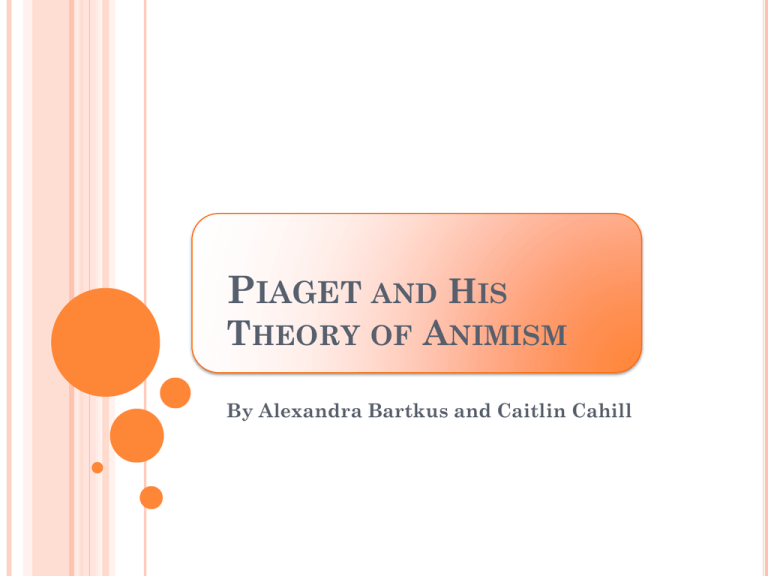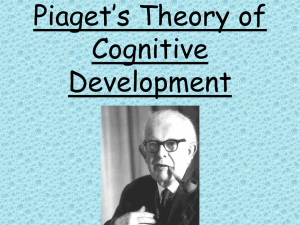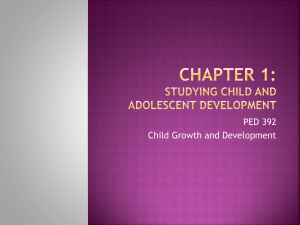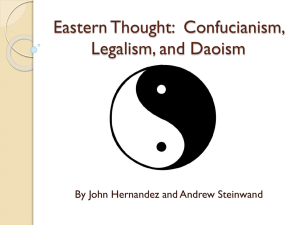
PIAGET AND HIS
THEORY OF ANIMISM
By Alexandra Bartkus and Caitlin Cahill
CONCEPT MAP:
WHO IS PIAGET?
JEAN WILLIAM FRITZ PIAGET
Born August 9, 1896 in
Neuchatel, Switzerland
Began his career at age 10
Received his PhD at the
University of Neuchatel.
Paris: studies wrong
answers of young boys
1923: married Valentine
Chatenay
With whom he had 3
kids:
Jacqueline
Lucienne
Laurent
BACKGROUND:
PIAGET’S STAGES OF COGNITIVE
DEVELOPMENT
Sensorimotor (from infancy to 2 years of age)
Pre-Operational (2-7 years old)
Concrete Operational (7-12 years old)
Formal Operational (12 years+)
= Animism
TERMINOLOGY:
Animism:
Example:
Children’s view of the
world as alive and
feeling.
Physiognomic Perception:
Werner’s idea that
children react to
energetic, emotional,
and expressive qualities
of objects
oChild Video Example
oSound of Music Clip
FOUR PHASES OF ANIMISM
1.
Animism associated with all objects (4-6 yrs)
2.
Example: A light bulb is alive because it gives
light.
Animism associated with any movement (6-8
yrs)
Example: A toy car is alive because it rolls.
3.
Animism associated with objects that move
on their own accord. (8 years and up)
4.
Animism no longer exists in a child when
they consider only plants and animals to be
alive.
THE PREMISE
Is animism gradually
abandoned within the four
stages of animism provided
by Piaget, or do children
abruptly abandon these
animistic perceptions of the
world?
GUIDING QUESTIONS
Will the questions we have created support
Piaget’s method of identifying animism?
Will the children, overall, display a general
replication of Piaget’s theory of the four stages of
animism?
Will there be distinct stages or will we see
transitioning children as well?
HYPOTHESIS:
Animism
is a gradually developing
process within a child’s cognitive
development. Children may
individually vary in their beliefs, but
the stages outlined by Piaget
encompass the majority of children in
cognitive development. Therefore,
animism is a continual and gradual
process that is abandoned over time
not abruptly.
METHODOLOGY: PART I
1.
2.
Students to be observed will be given the
handout.
Students will be presented with demonstrations
of the following items:
3.
A lamp
A balloon
A teddy bear
A toy car
A real potted flower
Students will be asked various questions.
Refer to the handout.
METHODOLOGY: PART II
1.
2.
Have the teacher or principal randomly choose
two students (one male and one female) from
the class studied.
Separately interview the two students on the
answers they recorded on their answer sheet.
The study will be conducted on
four separate classrooms.
DATA
HOW PIAGET EVALUATED DATA
“Is the sun alive?– Yes.– Why?– It gives light.– Is
a candle alive?– Yes because it gives light. It is
alive when it is giving light, but it isn’t alive when
it is not giving light. . . .Is the play-bell alive?–
Yes, it rings.” (Piaget, 1926, p. 196)
“Is a stone alive?– Yes.– Why?– It moves. . . How
does it move?– By rolling.– Is the table alive?–
No, it can’t move. . . . Is a bicycle alive?– Yes.–
Why?– It goes. (p. 196)
Crain, William. (2005). Theories of Development: Concepts and Applications. Upper Saddle
River, NJ: Pearson Prentice Hall.
PART I: RUBRIC FOR EVALUATING THE WORKSHEET
Points
0
1
Exception
Description
•Belief that
the object is
“Not Alive”
•Belief that
the object
“Not
Feeling”
•Belief that
the object
“Not
Knowing”
•Belief that
the object is
“Alive”
•Belief in
the object
having
“Feeling”
•Belief in
the object
“Knowing”
•Belief that
the Real
Flower is
“Alive” = 0
points.
WORKSHEET: RUBRIC FOR TOTAL POINTS
Total
Points
12-15
8-11
4-7
0-3
Stage of
Animism
1st Stage:
Animism
associated
with all
objects
2nd Stage:
Animism
associated
with any
movement
3rd Stage:
Animism
associated
with objects
that move
on their
own accord.
4th Stage:
Animism no
longer
exists in a
child when
they
consider
only plants
and animals
to be alive.
Ages that
this
typically
occurs*
4-6 years
6-8 years
8 years and
up
* According to Piaget
PART II: RUBRIC FOR EVALUATING INTERVIEW
Points
0
1
2
3
Description
Answer
reflected
that only
humans,
animals,
and plants
are alive.
Answer
reflected
belief that
the object
was alive
because of
movement
of its own
accord.
Answer
reflected
belief that
the object
was alive
because of
movement.
Answer
reflected
belief that
the object
was alive
because of
any
activity/con
sciousness .
INTERVIEW: RUBRIC FOR TOTAL POINTS
Total
Points
33-48
17-32
1-16
0
Stage of
Animism
1st Stage:
Animism
associated
with all
objects
2nd Stage:
Animism
associated
with any
movement
3rd Stage:
Animism
associated
with objects
that move
on their
own accord.
4th Stage:
Animism no
longer
exists in a
child when
they
consider
only plants
and animals
to be alive.
Ages that
this
typically
occurs*
4-6 years
6-8 years
8 years and
up
* According to Piaget
PIAGET’S STAGES OF ANIMISM: STAGES
PER GRADE
STAGES PER GRADE CHART
OVERALL IN EACH STAGE
PART I:
MALE-FEMALE COMPARISON
MALE-FEMALE COMPARISON
PART II: JUSTIFICATION OF RUBRIC
1ST GRADE:
Female: Worksheet Score: 2 / Interview Score: 24
1.
Q3: Does the Lamp know when the light is on, yes or no?
A: “No because it can’t
points
Q8: Is the Car alive, yes or no?
2.
see the light.” --- Werner: 3
A: “No, because it can’t move by itself.” --- Piaget: 1
point
Q11: Is the Giraffe alive, yes or no?
3.
A: “No
because he can’t move.” --- Piaget: 2 points
Male: Worksheet Score: 4 / Interview Score: 15
1.
Q1: Is the Lamp alive, yes or no?
A: “Yes because I was
Q8: Is the Car alive, yes or no?
2.
guessing.” --- No points
A: “No because it doesn’t move.” --- Piaget: 2 Points
Q12: Does the Giraffe feel anything when I scratch its head, yes or no?
3.
A: “No
because it won’t bite.” --- Werner: 3 points
3RD GRADE:
Female: Worksheet Score: 0 / Interview Score: 36
1.
2.
3.
Q1: Is the Lamp alive, yes or no?
A: “No because it can’t move.” --- Piaget: 2 points
Q4: Does the light feel anything when I touch it, yes or no?
A: “No because it didn’t see you touch it.”--- Werner:
3 points
Q10: Does the Car feel it is moving, yes or no?
A: “No because it doesn’t have hands.”-- Werner: 3
points
Male: Worksheet Score: 3 / Interview Score: 9
1.
2.
3.
Q2: When the Light is on, is the light alive, yes or no?
A: “Yes because it lights up and looks bright, like the
sun.”---Piaget: 3 Points
Q7: Does the Balloon feel when I push on it, yes or no?
A: “No, because it is just air inside plastic.”--- No points
Q10: Does the Car feel it is moving, yes or no?
A: “Yes, because it is moving because it has to step on
no wheels.”--- Piaget: 3 Points
5TH GRADE:
Female: Worksheet Score: 3 / Interview Score: 9
1.
2.
3.
Q1: Is the Lamp alive, yes or no?
A: “No because it has no soul. A soul is what makes
you.” --- No points
Q3: Does the Lamp know when the light is on, yes or no?
A: “Yes because my brother has a clap light, it would
have to know.”--- Piaget: 3 points
Q9: Does the Car know it is moving, yes or no?
A: “Yes because it has a motor and would have to know
it’s on.” --- Piaget: 3 points
Male: Worksheet Score: 2 / Interview Score: 3
1.
2.
3.
Q1: Is the Lamp alive, yes or no?
A: “No because it doesn’t have a mind or a heart.”--- No
points
Q6: Does the Balloon know I am blowing air into it, yes or no?
A: “No because it has no nerves for pressure.”--- No points
Q16: Does the Flower Feel when I touch it, yes or no?
A: “Yes because it would have feelings because it is
alive.” --- Piaget: 3 points
6TH GRADE:
Female: Worksheet Score: 2 / Interview Score: 9
1.
2.
3.
Q2: When the Light is on, is the light alive, yes or no?
A: “No because it is electricity powered, and I
always think alive as human-like.” --- Piaget: 3 points
Q10: Does the Car feel it is moving, yes or no?
A: “No because it doesn’t have a nervous system.”--No points
Q15: Does the Flower know when the sun is out, yes or no?
A: “Yes, if it is alive it can feel what is helping it
grow.”--- Piaget: 3 points
Male: Worksheet Score: 1 / Interview Score: 0
1.
2.
3.
Q1: Is the Lamp alive, yes or no?
A: “No because it doesn’t have a beating heart.”--No points
Q8: Is the Car alive, yes or no?
A: “No. It has a battery, not a heart.”--- No points
Q11: Is the Giraffe alive, yes or no?
A: “No because the Holy Spirit is not with it.”--- No
points
OVERALL RESULTS
FEMALE RESULTS
MALE RESULTS
GUIDING QUESTIONS: ANSWERED
Will the questions we have created support Piaget’s method
of identifying animism?
Will the children, overall, display a general replication of
Piaget’s theory of the four stages of animism?
Yes and No
Yes
Will there be distinct stages or will we see transitioning
children as well?
Not through the worksheets, but through the interviews– yes.
CONCLUSION:
Hypothesis = correct
Animism = gradually developing process ✓
Children may individually vary in their beliefs ✓
The stages outlined by Piaget encompass the
majority of children in cognitive development ✓
Animism is a continual and gradual process that is
abandoned over time not abruptly. ✓
SOURCES OF ERROR:
First grade class study only consisted of 6
students.
Allowing the teacher/principal to select the
students to be interviewed randomly: students
were very timid.
Distractions in the interview area.
WAYS TO IMPROVE THIS STUDY:
Include a Preschool class in the study.
Create a more effective yet unbiased way of
selecting the students to be interviewed.
Use a more controlled environment for the
interviews.
Find a more accurate way of objectifying the
subjective.
FURTHER STUDY:
Animistic development comparison between
males and females.
Compare Werner’s physiognomic perception to
Piaget’s animism based off of the same
observations.
Strictly interview-based research.
Study based more specifically to age.
NATURE NURTURE LINE
Nature
Montessori
Rousseau
Piaget
Vygotsky Caitlin
AlexSkinner
Bandura
Nurture
Locke










